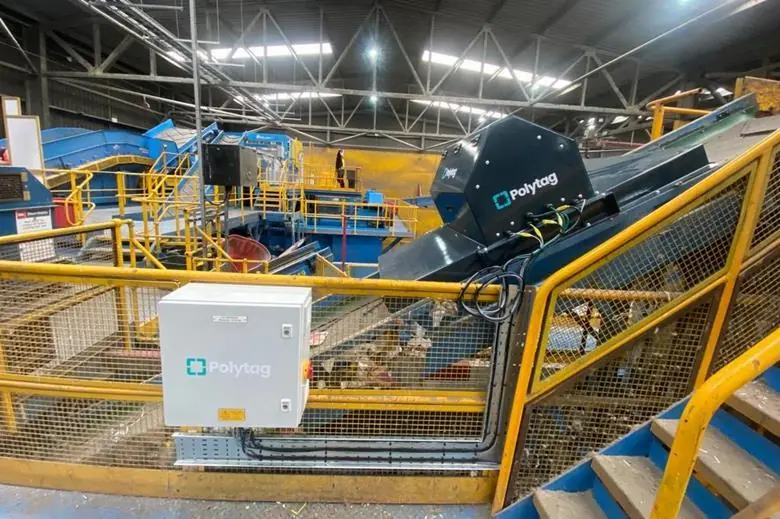Brands considering how to tag and trace their plastic products across the lifecycle are likely to spend time exploring Polytag, with its UV tag and GS1 data matrix system, and Digimarc, which embeds proprietary invisible codes into packaging artwork. While both aim to enhance recycling efficiency, their approaches offer different pathways toward sustainable packaging solutions and require different levels of effort from businesses.
Polytag’s Detection and Sortation Capability
Polytag’s system leverages UV-readable GS1 data matrix codes printed onto packaging using fluorescent ink. These codes are detected by Polytag UV tag readers. The system is designed to be open, interoperable, and scalable – built on GS1 open standards that allow any stakeholder to generate, detect, and decode packaging data.
Once detected, the data matrix reveals a rich payload of packaging attributes – ranging from the consumer packaging variant (CPV) and manufacturing site, to melt-flow temperature, food-grade status, plastic ‘generation’ (e.g. virgin or first/second generation recycled), and GTIN-level brand detail. This enables precise, real-time classification and sortation of both rigid and flexible plastics on high-speed conveyor belts.
In partnership with Pellenc ST, an optimised plastic packaging sortation capability is available, which combines near-infrared (NIR) optical sortation signals with the packaging attributes embedded in the data matrix UV tag to achieve high-quality bales of both rigid and flexible plastics.
Digimark’s use of pixel patterns
Digimarc embeds pixel patterns into packaging artwork using proprietary technology that adjusts pixel patterns across the entire package surface. Their system typically encodes barcode numbers within the watermark, which connects to a centralised database containing packaging information.
Detection requires specialized Digimarc software and hardware. The approach offers integrated data management and consistent quality control through their unified platform, though implementation requires significant artwork workflow changes and ongoing database connectivity for full functionality in recycling operations.
Comparing the Two Approaches
1. Payload Capability: Comprehensive Data vs Streamlined Information
Polytag’s use of GS1 data matrix codes allows for comprehensive packaging attribute encoding. This includes granular details like CPV, melt-flow temperature, and food-grade status – critical information for accurate sortation.
Digimarc’s invisible watermarking system takes a different approach, typically encoding a barcode number and utilizing external database lookups to retrieve additional information. While this keeps the embedded data lightweight, it may introduce dependencies on database connectivity for complete sortation decisions.
2. Ecosystem Approach: Open Standards vs Integrated Platform
Polytag is building an open ecosystem where anyone can generate a compliant GS1 data matrix, install a detection unit, or develop UV inks that meet performance standards. This creates multiple pathways for innovation and adoption.
Digimarc operates through a more integrated approach with a centralized platform that manages tag generation, detection, and decoding. While this ensures consistency, it creates a more unified but potentially less flexible ecosystem.
3. Implementation Requirements: Incremental Addition vs Comprehensive Integration
Adding Polytag UV tags to packaging requires an additional plate and colour channel on the printing press, with data matrices generated using readily available GS1 tools.
Digimarc’s approach involves more complex integration, requiring specialized software to adjust pixel patterns across packaging surfaces. This demands new workflows and skills, representing a more significant transition for brands, with new artwork or edited artwork requiring costly changes.
4. Global Deployment: Universal Standards vs Proprietary Technology
Polytag’s system leverages universal GS1 standards, enabling deployment anywhere with immediate functionality using standard data matrix reading capabilities. Detection units are designed to be cost-effective and open-specification.
Digimarc’s proprietary system ensures tight control over quality and performance but requires specific Digimarc software and hardware components, which may impact deployment flexibility and costs.
5. Real-Time Processing: Embedded Intelligence vs Connected Systems
Polytag’s UV tags carry complete sortation data within the code itself, enabling instantaneous processing decisions on high-speed conveyor belts without external dependencies. Digimarc’s approach often relies on database connectivity to access comprehensive packaging information, which, while ensuring data accuracy and updates, may introduce processing considerations in high-speed environments operating at up to 5 metres per second.
6. Sortation Integration: Direct Processing vs Connected Intelligence
Polytag’s integration with near-infrared (NIR) optical sorting enables immediate sortation decisions based on embedded data matrix information.
Digimarc’s system benefits from centralized data management, though the database dependency may create processing considerations in high-throughput, time-critical recycling environments.
Why Polytag Represents the Future of Recycling Infrastructure
While both technologies bring valuable innovations to packaging recycling, Polytag emerges as the more strategically sound choice for building tomorrow’s circular economy infrastructure. The fundamental advantages of Polytag’s approach create a compelling case for widespread adoption.
The open standards foundation ensures longevity and prevents technological obsolescence. By building on universally accepted GS1 standards, Polytag creates a system that can evolve and integrate with future innovations without requiring complete infrastructure replacement. This approach protects investments and encourages broader industry participation.
The Polytag model eliminates single points of failure. When all necessary data travels with the packaging itself, recycling facilities can operate independently, maintain consistent performance during network interruptions, and process materials with complete confidence in real-time. This is crucial for industrial-scale operations that cannot afford processing delays or dependencies.
The economic model supports rapid scaling. Lower implementation barriers for manufacturers, cost-effective detection equipment, and the elimination of ongoing database licensing costs make Polytag accessible to participants across the entire recycling value chain. This democratization of technology accelerates adoption and creates network effects that benefit the entire system.
Perhaps most significantly Polytag’s approach aligns with the fundamental requirements of effective recycling: absolute certainty about material composition, instantaneous processing capability, and the flexibility to handle the enormous variety of packaging in the global marketplace. These capabilities become increasingly critical as recycling volumes grow and quality requirements intensify.
The choice between these technologies ultimately represents a choice between building closed, dependency-heavy systems versus open, resilient infrastructure that can scale with the circular economy’s exponential growth. For an industry that must process billions of packages with perfect accuracy while remaining economically viable, Polytag offers the combination of technical excellence, economic accessibility, and strategic openness that sustainable recycling demands.
